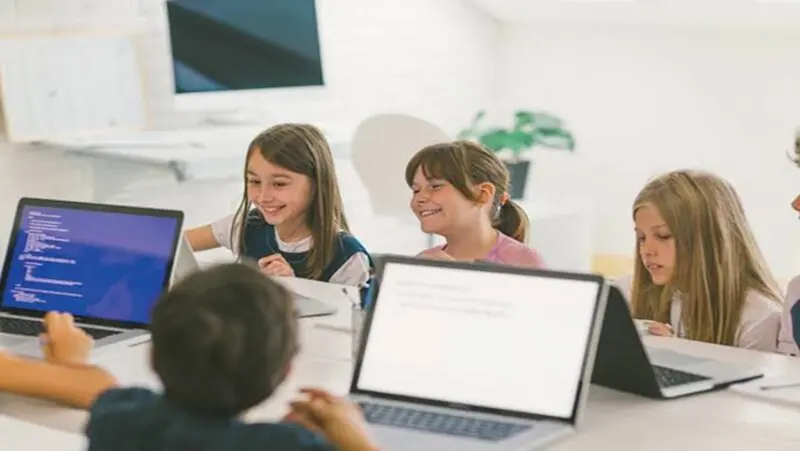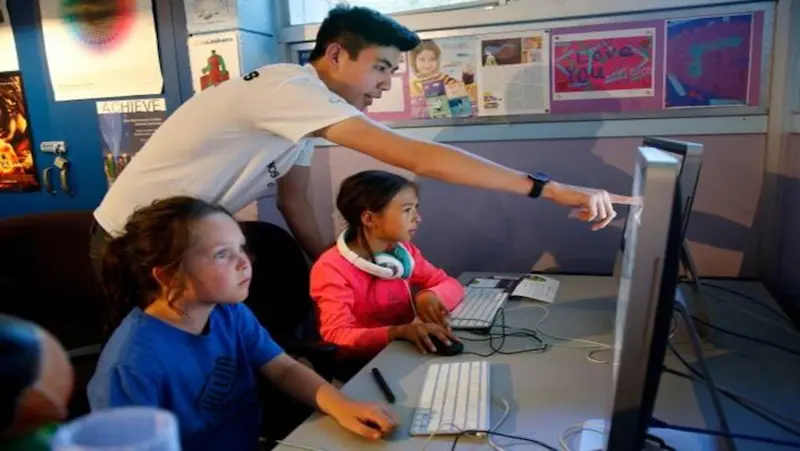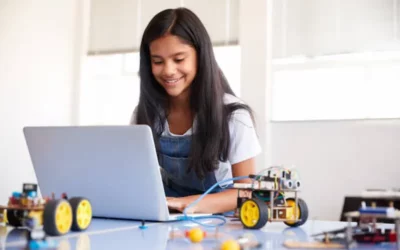Welcome, young coders and curious minds, to “The Ultimate Guide to Computer Coding for Kids!” In this exciting digital age, computer coding has emerged as an essential skill that empowers individuals to shape the world around them.
Learning to code not only fuels creativity but also nurtures problem-solving abilities, logical thinking, and critical reasoning from an early age. This comprehensive guide aims to unlock the fascinating world of coding games for kids, providing them with the tools they need to unleash their digital superpowers.
Table of contents
Introduction
In today’s digital age, computer coding has become an essential skill for children to acquire. With technology permeating every aspect of our lives, understanding coding empowers kids to actively participate in the digital world and shape its future.
By learning to code, children develop problem-solving abilities, logical thinking, and creativity while gaining the tools to build their dreams and navigate a tech-driven society. Coding classes for kids is more than just a hobby; it’s a pathway to innovation, opportunity, and limitless possibilities.
In today’s rapidly advancing technological landscape, computer coding has become an invaluable skill. As we prepare children for the future, it is crucial to introduce them to the world of coding at an early age.
Coding not only develops their problem-solving abilities but also empowers them to become creators rather than just consumers of technology. In this blog, we will explore the numerous benefits of teaching children to code and why it is an essential skill in the 21st century.
The benefits of teaching children to code:
Fosters Critical Thinking and Problem-Solving Skills:
Learning to code enables kids to think rationally, break down difficult problems into simpler, more manageable parts, and analyze complex situations. They must recognize trends, and flaws, and devise plans of action to find answers. Through coding, kids develop their critical thinking skills by learning how to approach problems logically and methodically.
Improves Innovation and Creativity:
Coding is a creative process that enables kids to bring their innovative thoughts to reality. It gives users a platform from which to create their own video games, narratives, animations, and software applications.
Children can explore their imagination, think creatively outside the box, and create original solutions to problems in the real world by playing with various coding principles. Coding feeds their creativity and equips them to become architects.
Enhances Math and Science Skills:
Mathematics and coding go hand in hand. Children naturally use mathematical reasoning when they develop programming. They study ideas like conditional statements, variables, sequences, and conditional algorithms, which form the basis of mathematical reasoning.
Coding furthermore entails testing out scientific ideas like cause and effect correlations. Children gain a greater knowledge of mathematics and science by incorporating coding into their schooling, making these disciplines more interesting and approachable.
Encourages Persistence and Resilience:
Learning to code is not always easy. Trial and error, issue fixing, and getting through obstacles are all part of it. Children learn the value of perseverance and resiliency via coding.
They are aware that failures are a necessary part of learning and that persistence is essential for success. Children learn problem-solving resilience through coding projects, which is an essential life skill transferable outside of the world of technology.
Enhances Computational Thinking:
The capacity for logical, systematic analysis and problem-solving is referred to as computational thinking. Children who learn to code learn how to deconstruct difficult issues into digestible chunks, and patterns, and create step-by-step solutions.
Children that possess these computational thinking abilities are better equipped to approach problems methodically and arrive at wise conclusions in a variety of spheres of life.

The potential career opportunities that coding can provide
In the digital age, coding has become an indispensable skill that opens the doors to a wide array of career opportunities. As technology continues to evolve and permeate various aspects of our lives, the demand for skilled programmers is on the rise.
Whether you’re a seasoned professional or a beginner looking to enter the tech industry, the potential career opportunities that coding offers are truly remarkable. In this blog post, we will explore some of the exciting paths that coding can lead you to and highlight the boundless prospects awaiting those with a passion for programming.
Software Engineering and Development
The most obvious professional route for coders is probably software development and engineering. You can develop programs, websites, and software systems if you are proficient in kids coding languages like Python, Java, C++, or JavaScript.
The need for knowledgeable software engineers remains strong regardless of whether you decide to work alone, join a startup, or join a major organization. Additionally, there will always be a demand for skilled coders in this industry due to the rising popularity of online development and mobile applications.
Analytics and data science
Data scientists and analysts are in high demand as a result of the big data era. These experts mine enormous amounts of data for useful insights using coding languages and analytical tools.
Data scientists are able to make data-driven judgments, forecast trends, and resolve challenging issues by utilizing their coding expertise, statistical understanding, and machine-learning skills. Data science and analytics careers are plentiful and lucrative as businesses in many industries come to understand the importance of data.
Ethical hacking and Cyber security
The need for cybersecurity specialists has never been higher due to the rise of cyber threats and our growing reliance on technology. Cybersecurity specialists in coding can assist businesses in defending their systems, networks, and data from harmful intrusions.
Penetration testers, commonly referred to as ethical hackers, use their coding expertise to find holes and flaws in systems, assisting businesses in tightening their security protocols. A profession in cybersecurity gives you a sense of purpose because you are instrumental in protecting private data and preserving the reliability of digital infrastructure.
Machine Learning and Artificial Intelligence
The fields of artificial intelligence (AI) and machine learning (ML) are developing quickly and significantly rely on coding. The algorithms and models created by AI and ML experts allow robots to learn from data and carry out intelligent activities.
AI and ML are used in a wide range of businesses, from personalized suggestions to self-driving cars. You can enter this exciting industry and help create intelligent systems that will impact the future by developing your skills in coding languages like Python or R.
Developing video games and virtual reality
Coding creates a road to game development and virtual reality (VR) for those who love gaming and immersive experiences. Games are created interactively and graphically stunningly by game developers using coding languages, gaming engines, and design tools.
Virtual reality is becoming increasingly popular, and developers with experience coding for VR platforms are in high demand. In addition to enabling you to bring engaging experiences to life, pursuing a career in game development or VR also gives you access to a thriving market with a devoted following.

Tips for Teaching Computer Coding to Kids
In today’s digital age, coding has emerged as an essential skill for the future. As parents, you have the power to nurture your children’s curiosity and equip them with the tools they need to thrive in a technology-driven world.
Teaching your children to code not only enhances their problem-solving abilities but also promotes creativity and logical thinking. To help you embark on this exciting journey, we’ve compiled a set of valuable tips and advice to guide you in selecting the right coding tools and creating a positive learning environment for your child.
Start with the Basics:
Emphasize the building blocks as you introduce your youngster to the principles of coding. Variables, conditionals, and loops are the building blocks of more complex programming concepts. Scratch or Blockly are two excellent places to start because they offer a graphical user interface that makes understanding coding principles simple.
Encourage Hands-On Learning:
Although theory is crucial, practice is the only way to truly master coding. Encourage your child to participate in practical coding projects and activities. Encourage your students to try new things, make mistakes, and grow from them. There is a tonne of coding projects and tutorials available for all ages on interactive coding platforms like Code.org, Khan Academy, and Tynker.
Foster a Positive Learning Environment:
Your child’s path into coding will be greatly aided by creating a positive and encouraging environment. Encourage their curiosity, recognize their accomplishments, and offer helpful criticism. Keep in mind that programming is a process and that failures present learning opportunities. By participating in coding activities together or setting up coding clubs where children can share knowledge and help one another, you can promote cooperation and problem-solving.
Select the Right Coding Tools:
Choosing the right coding tools is key to a successful learning experience. Consider your child’s age, interests, and learning style when selecting coding platforms or programming languages. Here are a few popular options:
a. Scratch:
Ideal for beginners, Scratch uses a visual programming language that allows children to create interactive stories, animations, and games.
b. Python:
Python is a versatile and beginner-friendly programming language widely used in the industry. Platforms like codecademy.com or repl.it offer interactive Python courses suitable for children.
c. Lego Mindstorms:
This robotics kit combines physical building blocks with coding, enabling children to build and program their own robots.
Integrate coding into routine tasks:
Find ways to incorporate coding into your child’s regular activities to help reinforce the principles taught. Encourage them to develop straightforward solutions for resolving issues or set them the responsibility of automating tedious tasks. Additionally, to demonstrate the applicability of their learning, point out examples of coding in real-world contexts, such as websites, applications, or video games.
Provide Real-World Context:
Assist your child in comprehending how coding techniques relate to actual situations. Tell success stories of people who employed coding to develop original solutions or launch fulfilling jobs. To introduce them to the larger coding community and encourage them to explore various coding disciplines, go to coding events, workshops, or hackathons.
Programming Languages for Kids
In today’s technology-driven world, introducing children to programming at an early age can ignite their creativity, critical thinking, and problem-solving skills. Programming languages designed for young learners provide an excellent platform to engage children in the exciting world of coding.
In this blog, we will explore three popular programming languages suitable for children: Scratch, Python, and Java
Scratch:
Scratch is an excellent choice for introducing young children (ages 8 and up) to programming. Developed by MIT, Scratch is a visual programming language that uses blocks of code that can be easily dragged and dropped to create interactive stories, animations, and games for kids on computer.
Its colorful interface, simple-to-understand blocks, and engaging characters make it a favorite among educators and young learners alike. Scratch coding for kids promotes creativity, logical thinking, and problem-solving skills, enabling children to express their ideas through coding without the need for complex syntax.
Python:
Python, known for its simplicity and readability, is a versatile programming language suitable for children of varying ages (from around 10 years old). Python’s syntax is designed to be beginner-friendly, allowing young learners to grasp fundamental programming concepts without feeling overwhelmed.
Python for kids offers a gentle learning curve and encourages students to write clean and organized code. With Python, children can create games, solve puzzles, build web applications, and even delve into artificial intelligence and data analysis.
Its extensive documentation, supportive community, and numerous online resources make it a popular choice for both self-paced learning and classroom environments.
Java:
While Java is considered a more advanced programming language, it can be suitable for older children (typically aged 12 and above) who are ready for a deeper dive into programming. Java’s object-oriented nature provides a solid foundation for understanding programming concepts such as classes, objects, and methods.
Although Java requires more attention to detail compared to Scratch and Python, it offers a powerful set of tools for developing applications, including mobile apps and games. Java’s popularity, industry relevance, and cross-platform compatibility make it an excellent choice for young learners aspiring to become professional programmers or software developers in the future.

Coding Games and Projects for Kids
In today’s digital age, computer coding has become an essential skill for children to learn. It not only enhances their problem-solving abilities but also promotes logical thinking and creativity.
To make the learning process more enjoyable and engaging, numerous coding games and projects have been developed specifically for children. These innovative resources combine education with entertainment, providing an interactive platform where young minds can explore the world of programming.
In this blog, we will showcase some of the most fun and educational computer basics for kids and projects that children can enjoy.
Scratch:
Scratch is a widely popular visual programming language designed for kids aged 8 and above. Children may make their own interactive tales, games, and animations using the program’s simple drag-and-drop interface.
Basic coding ideas like loops, conditionals, and variables are introduced in an entertaining way by Scratch. Children can share and work together on projects in the online community, which encourages creativity and teamwork.
CodeCombat:
CodeCombat is an exciting platform that transforms coding into an adventurous game. Children take on the role of a character in this game who uses lines of code to advance through various levels.
While engaging in combat, solving puzzles, and gathering wealth, they gain knowledge in programming languages like Python for kids and JavaScript. For both novice and seasoned coders, CodeCombat offers a well-structured curriculum that gradually exposes coding principles.
Robot Turtles:
A board game called Robot Turtles teaches coding principles to kids as young as four years old. It includes a concrete, practical method of teaching programming logic. Children direct their turtles through a maze by using cards to issue precise commands.
They gain knowledge of functions, conditional expressions, and loops as they advance. In addition to teaching coding skills, Robot Turtles fosters analytical reasoning and problem-solving capabilities.
Minecraft- Education Edition:
Minecraft, the immensely popular sandbox game, also has an educational version specifically designed for classrooms. Children may create and explore virtual worlds while learning coding skills with Minecraft: Education Edition.
Kids can write code using graphic programming tools or text-based coding languages like Python with the aid of “Code Builder,” a feature within the game. Children can directly observe how their code affects the game environment thanks to this immersive experience.
Bitsbox:
Bitsbox is a subscription-based service that delivers monthly coding projects to children aged 6 to 12. Kids receive a package of coding assignments every month, enabling them to create and modify their own apps.
Because Bitsbox uses a streamlined version of JavaScript, it is understandable to beginners. The projects gradually get more challenging, guaranteeing that learning never stops. Children gain a sense of success from this hands-on approach as they watch their apps come to life.
Overcoming Common Challenges
As parents, introducing coding to our children opens up a world of opportunities and equips them with problem-solving, critical thinking, and creativity. However, teaching children to code comes with its own set of challenges. In this blog, we will discuss some common hurdles parents may encounter when teaching their children to code and offer practical solutions to overcome them.
1. Lack of Patience and Engagement:
Challenge:
Children, especially younger ones, may struggle with focusing for long periods and may become easily disinterested or frustrated when faced with complex coding concepts
Solution:
- Start with interactive platforms: Utilize child-friendly coding platforms or apps that offer gamified learning experiences. These platforms provide engaging activities and visual cues that capture children’s attention and make learning enjoyable.
- Break it down: Divide complex coding concepts into smaller, manageable tasks. Encourage children to work on one aspect at a time, allowing them to grasp and master each concept before moving on to the next.
2. Overwhelming Complexity:
Challenge:
Coding can be complex and overwhelming, especially for beginners. Parents may find it challenging to explain abstract concepts in a simplified manner.
Solution:
- Use relatable examples: Relate coding concepts to real-life scenarios that children can easily understand. For instance, explain variables as containers holding different types of items, or loops as repeating a specific action like brushing teeth.
- Visual aids and diagrams: Utilize visual aids, such as flowcharts or diagrams, to visually represent coding logic and processes. Visual representations can help children visualize the code’s execution and understand its flow.
3. Fear of Making Mistakes:
Challenge:
Children may fear making mistakes or worry about not getting the code right, hindering their learning process and experimentation.
Solution:
- Encourage a growth mindset: Teach children that making mistakes is part of the learning process. Emphasize that mistakes provide opportunities for growth and improvement. Foster a positive environment where children feel comfortable taking risks and learning from their errors.
- Celebrate progress: Focus on celebrating the effort and progress children make rather than solely on the end result. Encourage children to reflect on their achievements and how they overcame obstacles, boosting their confidence and resilience.
4. Limited Access to Resources and Support:
Challenge:
Parents may struggle to find suitable resources or lack the necessary coding knowledge to guide their children effectively.
Solution:
- Online coding communities: Engage with online coding communities and forums specifically tailored for young coders and parents. These communities provide valuable resources, tutorials, and a support network where parents can seek guidance and advice.
- Coding clubs and camps: Explore local coding clubs or camps where children can learn coding alongside their peers. These programs often provide structured learning experiences, mentorship, and access to experts who can assist children in their coding journey.
5. Balancing Screen Time and Real-World Activities:
Challenge:
Striking a balance between coding activities and other essential real-world activities can be a concern for parents
Solution:
- Time management: Set specific time slots for coding activities to ensure a balanced routine. Encourage children to explore other hobbies and activities that promote physical exercise, social interaction, and creativity.
- Incorporate coding into everyday life: Look for opportunities to integrate coding concepts into daily activities. For example, encourage children to automate tasks or create simple programs that solve real-world problems. This way, children’s coding classes become a part of their regular routine rather than an isolated activity.

Conclusion
In conclusion, the resources provided in the guide serve as valuable tools for parents to support and encourage their children’s success in coding. By leveraging these resources effectively, parents can play a significant role in fostering their children’s interest, confidence, and proficiency in programming.
The guide equips parents with practical strategies, tips, and recommended platforms to engage their children in coding activities and ensure a productive learning experience.
By actively utilizing the resources, parents can create a conducive learning environment at home and nurture their children’s coding skills. They can leverage online coding platforms, coding games, and interactive tutorials mentioned in the guide to make learning enjoyable and interactive.
These resources provide a structured and engaging approach to learning coding concepts, helping children build a strong foundation.
Additionally, the guide emphasizes the importance of parental involvement and support throughout the coding journey. Parents can take an active interest in their children’s projects, provide constructive feedback, and help troubleshoot coding challenges.
This involvement fosters a sense of collaboration, motivation, and perseverance in children, enhancing their learning outcomes and problem-solving abilities.
BrightChamps is an extraordinary platform that ignites young minds with the power of coding. It is a creative wonderland where kids dive into the captivating world of programming, learning to unravel complex algorithms and craft their own digital masterpieces.
With a holistic curriculum, CodeChamps nurtures the innate problem-solving abilities of children, fostering their creativity and critical thinking. CodeChamps is where dreams come alive, and the future of innovation takes flight.
Overall, the resources provided in the guide empower parents to actively engage in their children’s coding journey and help them succeed. By utilizing these resources effectively, parents can inspire a lifelong love for coding, equip their children with valuable skills for the future, and lay a solid foundation for their academic and professional growth.
Together, parents and their children can navigate the exciting world of coding, unlocking a multitude of opportunities and unleashing their creative potential.
Frequently Asked Questions
Computer coding is the process of creating instructions for computers to follow. It is important for kids to learn to code as it develops problem-solving skills and promotes creativity in the digital age.
Scratch, Python, and JavaScript are some of the best coding languages for kids to begin with due to their simplicity and versatility.
Learning to code at a young age enhances logical thinking, fosters computational skills, and prepares kids for future careers in technology.
You can help your child get started with coding by exploring online coding tutorials, enrolling them in coding camps or clubs, or providing coding books and resources.
Creating a game, designing a website builder for kids, or building a simple robot are fun coding projects that kids can try at home.
Yes, there are free online resources such as Code.org, Scratch, and Khan Academy that offer interactive coding lessons for kids.
Coding skills open up a wide range of career opportunities in fields like software development, data analysis, artificial intelligence, and web development.
A basic computer or laptop with internet access is sufficient to get started with coding. Some coding can also be done on tablets or smartphones.
Yes, children can learn coding even without prior experience. There are beginner-friendly resources available that introduce coding concepts in a simple and engaging manner.
There are various coding classes and programs available for kids, including online courses, coding camps, and coding clubs. The best one depends on your child’s interests and learning style.


 We are an army of educators and passionate learners from BrightChamps family, committed to providing free learning resources to kids, parents & students.
We are an army of educators and passionate learners from BrightChamps family, committed to providing free learning resources to kids, parents & students.








